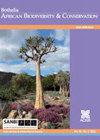除草剂百草枯对niloticus(慈鲷科)和Macrobrachium olfersii (PALAEMONIDAE)的急性毒性。
IF 0.5
4区 生物学
Q4 PLANT SCIENCES
引用次数: 0
摘要
百草枯是一种用于农业杂草和灌木控制的除草剂,其作用方式是接触性和非选择性的。由于其高水溶性和低挥发性,它对非目标生物具有潜在的风险。对韦拉克鲁斯州的水产养殖业来说,尼罗提斯罗非鱼(Oreochromis niloticustilapia)和奥氏沼虾(对虾)是重要的商业品种。本研究的目的是通过急性毒性生物测定(96小时)确定除草剂Dasurquat®(活性成分百草枯)的平均致死浓度(LC50)。niloticus幼鱼(平均体重= 10毫克,总长度= 8.75毫米)和幼鱼。以平均体重为5 mg,总长度为5.72mm的大蠹蛾幼虫为试验标本。施用浓度分别为罗非鱼5、10、20、40和80µl/ l,对虾0.1、0.2、0.5、0.7和1µl/ l。实验设计考虑阴性对照,每个处理有两个重复和两个重复。Probit分析结果表明,O. niloticus96 h lc50为17.49µl l -1, 95%置信下限为13.75µl l -1,上限为22.25µl l -1; M. olfersii96 h lc50为0.31µl l -1, 95%置信下限为0.26µl l -1,上限为0.35µl -1。方差分析表明,各处理重复间差异无统计学意义(p >0.05)。结论认为,由于该除草剂在韦拉克鲁斯州农业活动中广泛使用,有必要继续评估其对水生生物的毒性,以确定其对其他活动的潜在风险。本文章由计算机程序翻译,如有差异,请以英文原文为准。
TOXICIDAD AGUDA DEL HERBICIDA PARAQUAT EN Oreochromis niloticus (CICHLIDAE) Y Macrobrachium olfersii (PALAEMONIDAE).
Paraquat is an herbicide used in the agricultural industry for weed and undergrowth control, its mode of action is by contact and non-selective. Due to its high-water solubility and low volatility, it represents a potential risk for non-target organisms. Oreochromis niloticustilapia and the prawn Macrobrachium olfersiiare important commercial species for Veracruz´s aquaculture industry. The objective of this study was to determine the Mean Lethal Concentration (LC50) of the herbicide Dasurquat® (active ingredient Paraquat) through an acute toxicity bioassay (96 hours). Juvenile O. niloticus(average weight = 10 mg, total length = 8.75 mm) and juvenileM. olfersiipostlarvae (average weight = 5 mg, total length = 5.72mm) were used as test specimens. Five herbicide concentrations (5, 10, 20, 40 and 80 µl/L for tilapia and 0.1, 0.2, 0.5, 0.7 y 1 µl/L for prawn) were applied. The experimental design considered a negative control, with two replications and two replicates for each treatment. Probit analysis determined that the LC50at 96 hours for O. niloticuswas 17.49 µl L-1, with a lower 95 % confidence limit of 13.75 µl L-1and an upper limit of 22.25 µl L-1, whereas for M. olfersiithe LC50at 96 hours was 0.31 µl L-1, with a lower 95 % confidence limit of 0.26 µl L-1and an upper limit of 0.35 µl L-1. The analysis of variance showed that there was no significant statistical difference (p >0.05) between the replicates of the treatments. It is concluded that it is necessary to continue evaluating its toxicity in aquatic organisms due to the wide use of this herbicide in Veracruz´s agricultural activity, to determine its potential risk to other activities.
求助全文
通过发布文献求助,成功后即可免费获取论文全文。
去求助
来源期刊

Bothalia
生物-植物科学
CiteScore
1.70
自引率
0.00%
发文量
12
期刊介绍:
Bothalia: African Biodiversity & Conservation is published by AOSIS for the South African National Biodiversity Institute (SANBI) and aims to disseminate knowledge, information and innovative approaches that promote and enhance the wise use and management of biodiversity in order to sustain the systems and species that support and benefit the people of Africa.
The journal was previously published as Bothalia, and had served the South African botanical community since 1921. However the expanded mandate of SANBI necessitated a broader scope for the journal, and in 2014, the subtitle, African Biodiversity & Conservation was added to reflect this change.
 求助内容:
求助内容: 应助结果提醒方式:
应助结果提醒方式:


